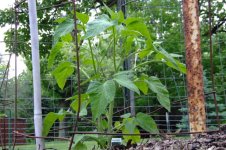</font><font color="blue" class="small">( This is probably the first year where I have waited until the end of May to start setting out most of the plants. We have had so much rain that all of the corn is still not in the ground. Looks like it will be late this year. )</font>
Mike, I haven't added anything to your thread because my only tip would be that if it's hot and dry, you will have to spend a lot of time watering. My garden is going great and the corn seems to really be thriving. I have a couple of plants that are almost 5' tall. I'll surely have plenty of corn-on-the-cob for July 4th. Heck! I'll probably have some Golden Bantam in two weeks. /forums/images/graemlins/grin.gif
I was sitting in a small local cafe this weekend, and a fellow walked in who is a melon farmer. He has 20 acres in melons locally and another 20 acres in East Texas near Terrell. He said this year he took a chance because of the hot weather and planted his melons on March 15 instead of the second week in April. In two weeks, he's picking melons. /forums/images/graemlins/cool.gif
This fellow said he was experimenting with black plastic row covers. He told me that he spent a bunch of money on plastic rolls, but that the moisture was trapped beneath the plastic and those plants were doing very well with no water. He said he waited until he got the first good rain of spring and then put the plastic down.
My melons are just starting to bloom, so I doubt I'll have any of my own melons by July 4th. /forums/images/graemlins/frown.gif Next year I'll have to start at least two weeks earlier.
Here's another tip. I noticed my pea vines were covered with aphids on Friday. The plants were also loaded with ladybugs. I didn't want to kill the ladybugs, so Saturday morning we took a water hose with a spray nozzle and washed the aphids off the plants. Yesterday, we saw the ladybugs were back, but only four or five plants had aphids. We hit those with soapy water. Now. we'll watch closely and try to spot soap and let the ladybugs do most of our cleanup. We saw lots of ladybugs making more ladybugs on the plants, so we hope their numbers will increase and keep the aphids wiped out.

